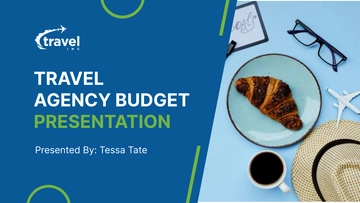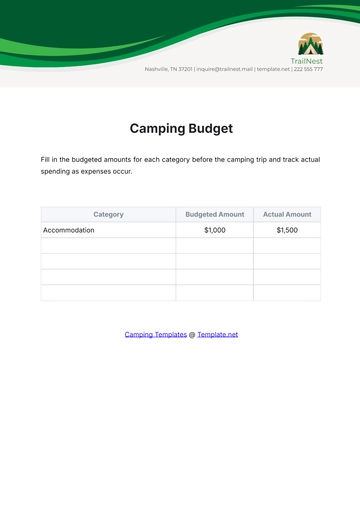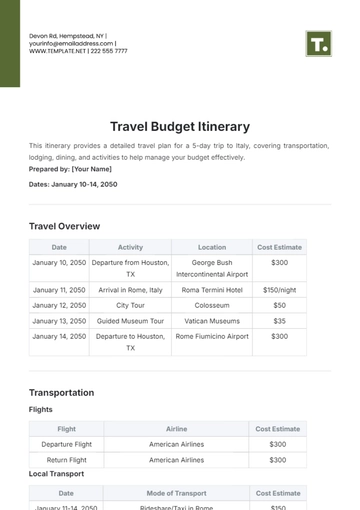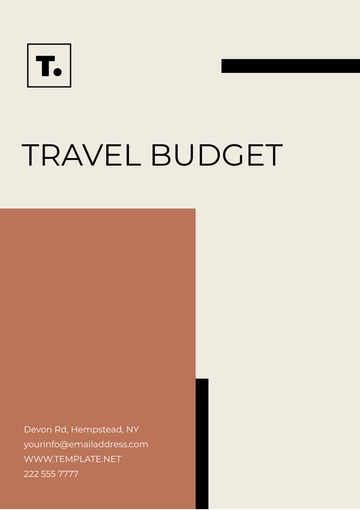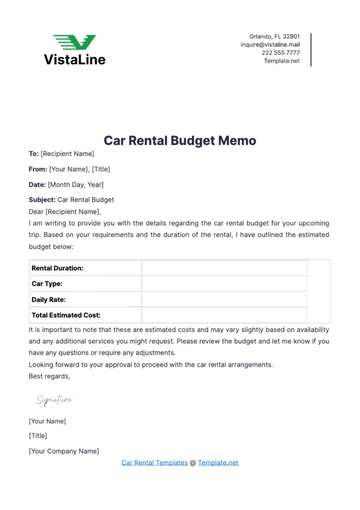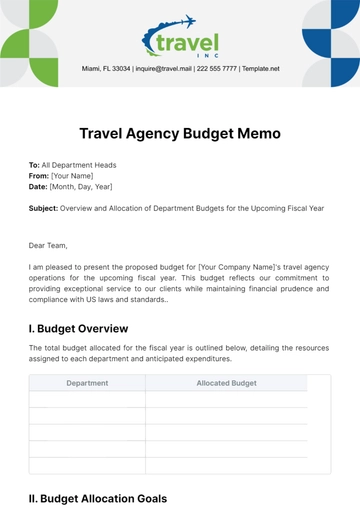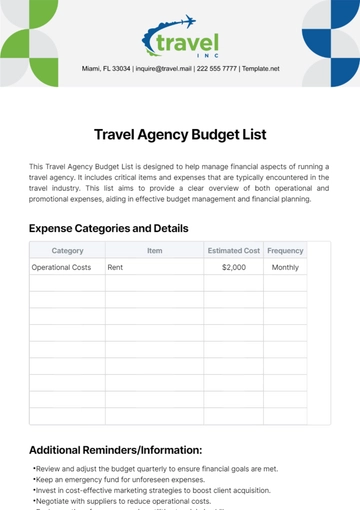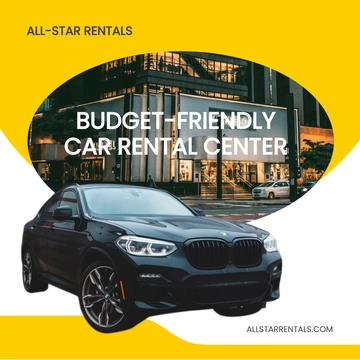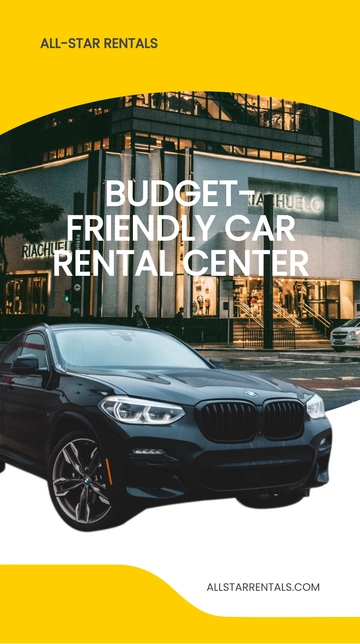Free Travel Agency Budget Report
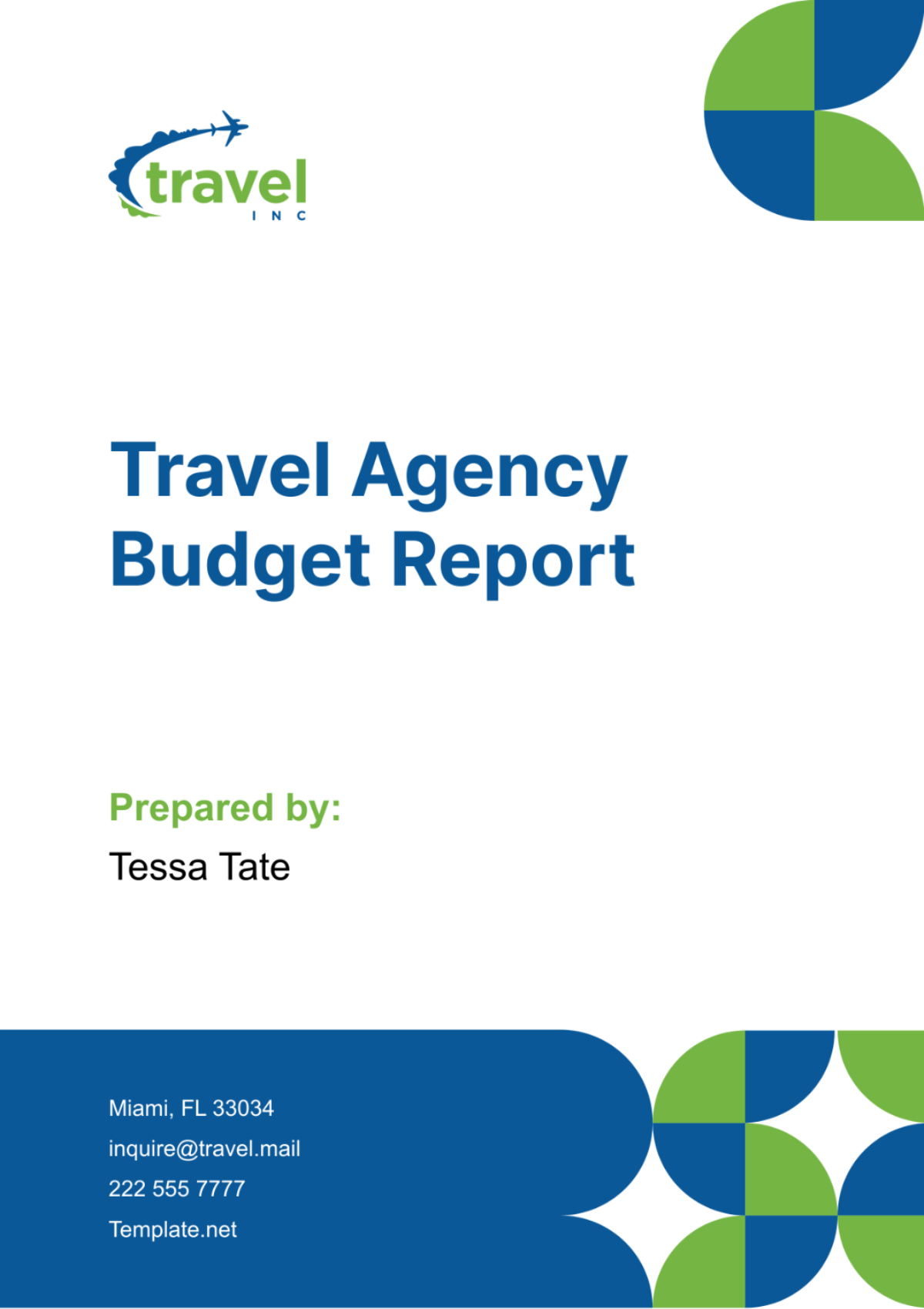
I. Executive Summary
A. Overview
[Your Company Name], one of the leading travel agencies in the region, presents the budget report for the fiscal year [Year]. This report aims to provide stakeholders with a comprehensive overview of the financial performance and strategic outlook of the agency.
B. Key Findings
The fiscal year [Year] saw [Your Company Name] achieve significant milestones despite challenges posed by the global pandemic and fluctuating travel restrictions.
Total revenue increased by [10%] compared to the previous year, reaching [$2,500,000], driven by a surge in domestic travel and strategic partnerships with airlines and hotels.
Operating expenses rose by [8%], totaling [$1,800,000], primarily due to increased marketing expenditures aimed at expanding market reach and enhancing brand visibility.
Despite the rise in expenses, [Your Company Name] maintained a healthy profit margin of [15%], underscoring the agency's resilience and efficient cost management practices.
II. Financial Performance Analysis
A. Revenue
Total revenue for the fiscal year [Year] amounted to [$2,500,000], reflecting a [10%] increase from the previous year. This growth was fueled by a resurgence in travel demand as pandemic-related restrictions eased, coupled with strategic initiatives to capture market share and diversify revenue streams.
Airline ticket sales remained the primary revenue driver, accounting for [48%] of total revenue. [Your Company Name] capitalized on partnerships with major airlines, offering competitive fares and exclusive deals to customers.
Hotel bookings constituted [32%] of total revenue, with [Your Company Name] leveraging its extensive network of hotel partners to provide a wide range of accommodation options to travelers, from budget-friendly to luxury resorts.
Tour packages and other ancillary services contributed [12%] and [8%], respectively, to total revenue. [Your Company Name] curated immersive travel experiences, including guided tours, adventure packages, and customized itineraries, catering to diverse traveler preferences.
B. Expenses
Operating Expenses:
Expense Category | Amount ($) | Percentage (%) |
|---|---|---|
Marketing | [$500,000] | [28%] |
Employee Salaries | [$600,000] | [33%] |
Rent & Utilities | [$150,000] | [8%] |
Technology | [$200,000] | [11%] |
Miscellaneous | [$350,000] | [20%] |
Total Operating Expenses | [$1,800,000] | [100%] |
Marketing expenses accounted for the largest portion of operating expenses, reflecting [28%] of total expenses. [Your Company Name] executed targeted marketing campaigns across various channels, including online advertising, email marketing, and collaborations with travel influencers, to drive brand awareness and customer engagement.
Employee salaries constituted [33%] of total expenses, reflecting [Your Company Name]'s commitment to nurturing a talented workforce capable of delivering exceptional customer service and operational excellence. Training programs, employee benefits, and performance incentives were integral components of [Your Company Name]'s human resources strategy.
Rent and utilities expenses represented [8%] of total expenses, reflecting [Your Company Name]'s investment in maintaining a network of physical offices and customer service centers to support its operations and serve as touchpoints for clients.
Technology investments, totaling [11%] of total expenses, were directed towards enhancing the digital infrastructure and technological capabilities of [Your Company Name]. This included investments in website development, mobile applications, reservation systems, and data analytics tools to optimize business processes, improve customer experience, and drive operational efficiency.
Miscellaneous expenses, comprising [20%] of total expenses, encompassed a variety of operational costs, including office supplies, travel insurance, professional services, and administrative expenses necessary for day-to-day operations.
C. Profit Analysis
Gross Profit Margin: [42%]
Net Profit Margin: [15%]
These figures underscore [Your Company Name]'s ability to achieve strong profitability while effectively managing expenses and delivering value to customers. Despite challenges posed by the dynamic nature of the travel industry, [Your Company Name] remains resilient and well-positioned for sustained growth and success in the future.
III. Budget Allocation
A. Marketing Budget
The marketing budget for the fiscal year [Year] was strategically allocated to maximize brand visibility, attract new customers, and retain existing ones. A total of [$500,000] was earmarked for marketing initiatives, with the following breakdown:
Marketing Channel | Budget Allocation ($) | Percentage (%) |
|---|---|---|
Digital Advertising | [$200,000] | [40%] |
Social Media Campaigns | [$100,000] | [20%] |
Collaborations & Events | [$150,000] | [30%] |
Print Media | [$50,000] | [10%] |
Total | [$500,000] | [100%] |
Digital advertising represented the largest portion of the marketing budget, reflecting [40%] of total expenditures. [Your Company Name] invested in targeted online advertisements, search engine marketing (SEM), and pay-per-click (PPC) campaigns to reach potential customers actively searching for travel services.
Social media campaigns accounted for [20%] of the marketing budget, with [Your Company Name] leveraging popular platforms such as Facebook, Instagram, and Twitter to engage with followers, showcase travel destinations, and promote special offers and discounts.
Collaborations and events received [30%] of the marketing budget, enabling [Your Company Name] to forge partnerships with travel influencers, bloggers, and local businesses to amplify its brand presence and reach new audiences through sponsored content, joint promotions, and participation in travel expos and events.
Print media advertising, including brochures, flyers, and magazine placements, constituted [10%] of the marketing budget, targeting offline audiences and providing tangible marketing collateral for distribution at physical locations and trade shows.
B. Employee Expenses
Employee expenses remained a significant allocation in [Your Company Name]'s budget, totaling [$600,000]. This allocation encompassed various components, including salaries, benefits, training, and development programs, to ensure a skilled and motivated workforce capable of delivering exceptional service to customers.
C. Technology Investments
Technology investments were prioritized to enhance [Your Company Name]'s operational efficiency, customer experience, and competitive edge in the market. A total of [$200,000] was allocated to technology initiatives, with the following breakdown:
Technology Investment | Budget Allocation ($) | Percentage (%) |
|---|---|---|
Website Development | [$80,000] | [40%] |
Reservation Systems | [$60,000] | [30%] |
Mobile Applications | [$40,000] | [20%] |
Data Analytics Tools | [$20,000] | [10%] |
Total | [$200,000] | [100%] |
Website development received the largest share of the technology budget, reflecting [40%] of total expenditures. [Your Company Name] invested in revamping its website infrastructure, enhancing user interface (UI) and user experience (UX) design, and implementing e-commerce functionalities to facilitate seamless booking and payment processes for customers.
Reservation systems, comprising [30%] of the technology budget, were upgraded to streamline booking workflows, optimize inventory management, and integrate with third-party travel suppliers to expand product offerings and improve booking accuracy and efficiency.
Mobile applications accounted for [20%] of the technology budget, reflecting [Your Company Name]'s commitment to mobile-first strategies and catering to the growing segment of travelers who prefer to book and manage their trips via smartphones and tablets. Investments were made in developing intuitive mobile apps compatible with iOS and Android platforms, offering personalized travel recommendations, real-time notifications, and itinerary management features.
Data analytics tools represented [10%] of the technology budget, enabling [Your Company Name] to harness data-driven insights and business intelligence for strategic decision-making, customer segmentation, and personalized marketing initiatives. Investments were made in analytics platforms, predictive modeling algorithms, and reporting dashboards to analyze market trends, track key performance indicators (KPIs), and optimize marketing ROI and operational performance.
IV. Future Outlook
A. Opportunities
[Your Company Name] remains optimistic about future growth opportunities within the travel industry, driven by evolving consumer preferences, emerging travel trends, and technological advancements. Key opportunities include:
Expansion into new markets: [Your Company Name] will explore opportunities to expand its geographic footprint and target new customer segments, including niche travel markets and underserved regions.
Diversification of product offerings: [Your Company Name] will diversify its product portfolio to include experiential travel packages, sustainable tourism initiatives, and wellness retreats, catering to evolving consumer preferences and lifestyle trends.
Strategic partnerships and alliances: [Your Company Name] will continue to forge strategic partnerships with airlines, hotels, tourism boards, and other travel stakeholders to enhance product offerings, access exclusive deals, and expand distribution channels.
B. Threats
Despite promising opportunities, [Your Company Name] faces several challenges and threats that may impact its operations and profitability. Key threats include:
Economic uncertainty: [Your Company Name] remains vigilant of macroeconomic factors such as economic downturns, currency fluctuations, and geopolitical tensions that may affect consumer spending on travel and tourism.
Competitive pressures: [Your Company Name] faces intense competition from online travel agencies (OTAs), meta-search engines, and alternative lodging providers, necessitating continuous innovation, differentiation, and customer-centric strategies to maintain market share and competitiveness.
Regulatory changes and travel restrictions: [Your Company Name] is closely monitoring evolving regulations, government policies, and travel restrictions related to health and safety protocols, visa requirements, and border closures, which may disrupt travel patterns, booking behavior, and destination accessibility.
C. Recommendations
To mitigate risks and capitalize on opportunities, [Your Company Name] proposes the following recommendations:
Agile business strategies: [Your Company Name] will adopt agile business strategies and flexible operating models to respond swiftly to changing market conditions, consumer preferences, and regulatory environments.
Innovation and technology adoption: [Your Company Name] will prioritize innovation and technology adoption to enhance operational efficiency, customer engagement, and competitive advantage, leveraging emerging technologies such as artificial intelligence (AI), blockchain, and augmented reality (AR) to revolutionize the travel experience.
Customer-centric approach: [Your Company Name] will remain committed to delivering exceptional customer experiences through personalized services, seamless booking processes, and proactive customer support, building long-term loyalty and advocacy among travelers.
Risk management and contingency planning: [Your Company Name] will implement robust risk management frameworks and contingency plans to mitigate operational, financial, and reputational risks, ensuring business continuity and resilience in the face of unexpected disruptions and crises.
V. Conclusion
A. Financial Performance
[Your Company Name] has demonstrated robust financial performance in [Year], with a [10%] increase in total revenue compared to the previous year, reaching [$2,500,000]. Despite facing challenges posed by the global pandemic and fluctuating market conditions, the agency maintained a healthy profit margin of [15%], underscoring its resilience and effective cost management practices.
B. Strategic Investments
[Your Company Name] strategically allocated resources to key areas such as marketing, employee development, and technology, positioning the agency for long-term growth and competitiveness. Investments in digital marketing initiatives, employee training programs, and technological enhancements have strengthened [Your Company Name]'s market position and enhanced its ability to meet evolving customer needs and preferences.
C. Customer-Centric Approach
Your Company Name] remains committed to delivering exceptional customer experiences by offering personalized services, innovative travel solutions, and responsive customer support. The agency's customer-centric approach has fostered strong relationships with clients and contributed to positive word-of-mouth referrals and repeat business.
D. Outlook
Looking ahead, [Your Company Name] is optimistic about its future prospects and growth opportunities within the travel industry. By leveraging its strong financial foundation, strategic investments, and customer-centric ethos, the agency is poised to capitalize on emerging trends, expand its market reach, and maintain its position as a leader in the travel sector.
- 100% Customizable, free editor
- Access 1 Million+ Templates, photo’s & graphics
- Download or share as a template
- Click and replace photos, graphics, text, backgrounds
- Resize, crop, AI write & more
- Access advanced editor
Manage your agency's finances effectively with Template.net's Travel Agency Budget Report Template. This customizable document provides a structured format for outlining your agency's budget, including income, expenses, and forecasts. With clear sections for revenue sources, expenditure categories, and variance analysis, it helps you monitor financial performance and make informed decisions. Editable in our Ai Editor Tool for seamless customization and integration into your agency's financial planning processes.
You may also like
- Budget Sheet
- Personal Budget
- Non Profit Budget
- Monthly Budget
- Project Budget
- HR Budget
- Company Budget
- Home Budget
- Weekly Budget
- College Budget
- Business Budget
- Construction Budget
- Small Business Budget
- Hotel Budget
- Annual Budget
- Home Renovation Budget
- Household Budget
- Student Budget
- Grocery Budget
- Marketing Budget
- Corporate Budget
- Startup Budget
- Manufacturing Budget
- Church Budget
- University Budget
- Annual Budget Plan
- Event Budget
- Operating Budget
- Travel Budget
- Food Budget
- IT and Software Budget
- School Budget
- Real Estate Budget
- Sales Budget
- Conference Budget
- Budget Finance
- Freelancer Budget
- Budget Advertising
